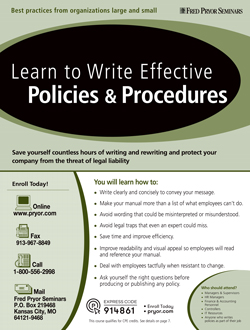Here's just some of what we'll cover:
- Wording that could land your company in a legal landmine
- The difference between a policy and a procedure - and how to reflect them in your writing style
- Red flags that tell you a policy should be reconsidered or communicated more effectively
- Shortcuts that trim hours off your writing and compilation time
- Guidelines on writing policies and procedures about sensitive subjects without offending
- How to make sure your manual doesn't turn into a long list of "don'ts"
- Four questions to ask yourself before publishing any policy
Write clear, concise policies and procedures that eliminate gray areas and end confusion
Writing policies and procedures is probably one of your least favorite tasks, maybe even something you've been putting off for weeks - or months. You know it has to be done, but it seems like there's always something more pressing to handle. And when you do try to get started, you have so many questions about the process…
- "Is it best to write in the positive, or do I focus on what employees should NOT do?"
- "What exactly are the legal traps I need to watch out for?"
- "Can I post this on our Web site, so it will be easy to update…or should I distribute hard copies?"
- "What are the specific words and phrases that make people angry? I really want to avoid those!"
- "I'm no writer - so how am I ever going to tackle this job?
You can get the help you need and answers to all these questions - including dozens you haven't even thought to ask - at this information-packed one-day seminar. Here's the simple truth: Well-written, concise policies and procedures are the framework that holds your organization together and makes everything run smoothly and efficiently. Attend this one-of-a-kind, career-enhancing program and learn valuable techniques for writing policies and procedures with skill and ease.
Don't wait until there's an unfortunate misunderstanding, a critical mistake, or even a lawsuit that solid documentation could have prevented. Take action today!
